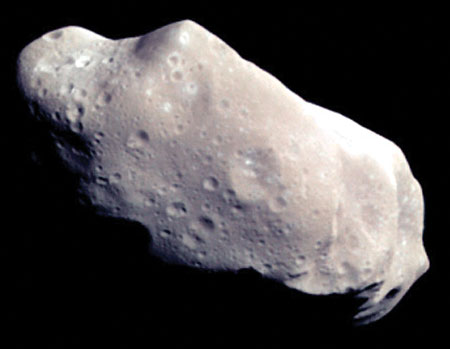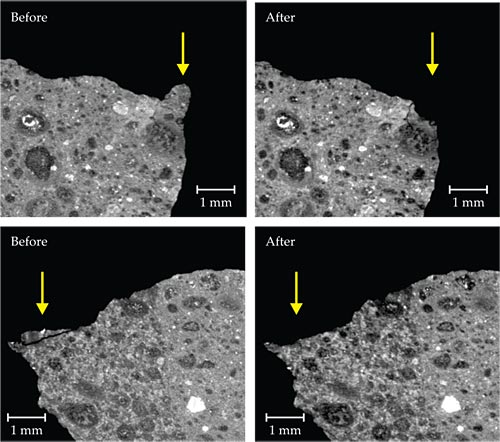Thermal cycling breaks down asteroid boulders
DOI: 10.1063/PT.3.2405
Like the Moon, Mars, and other rocky bodies in the solar system, asteroids are covered with a layer of pebbles, sand, and dust, called regolith. Given that asteroids formed when large boulders coalesced under their mutual gravity, the presence of regolith requires that surface rock be broken up somehow.
For asteroids 1 km across or smaller, whatever process makes regolith cannot be so energetic that ejected fragments acquire sufficient velocity to escape the asteroids’ feeble gravity. Bombardment by micrometeorites meets that criterion. Observed by astronauts on the Moon, it had been thought to be the only process at play.
Now Marco Delbo of the Côte d’Azur Observatory in Nice, France, and his collaborators have identified a second process: thermal cycling. 1 As asteroids spin about their rotation axes, their surfaces plunge in and out of shadow. Provided the rotation rate is neither so fast that solar irradiation is effectively constant nor so slow that rocks have time to adjust, the oscillating thermal stress opens and extends cracks in asteroid rock.
Delbo and his collaborators made their discovery by using pieces of meteorite as asteroid surrogates and cycling the ambient temperature every 2.2 hours. After 37 days, cracks had lengthened at an average rate of 0.5 mm/y. By incorporating their measurements into a fracture model, the researchers deduced that thermal cycling was more efficient than micrometeorite bombardment at fragmenting rock—in some cases by orders of magnitude.
Until a spacecraft lands on an asteroid and drills deep into its interior, the dust, pebbles, and boulders on its surface remain the only parts that we can see or sample. “Understanding how regolith forms could tell us about more than just the surface,” says Delbo.
Desert rocks
The idea that thermal cycling might generate regolith came about when Simone Marchi of the Southwest Research Institute in Boulder, Colorado, visited Delbo in Nice. Marchi remarked that some asteroids whose orbits are now near Earth’s used to pass so close to the Sun that the Sun’s heat could conceivably alter the asteroids’ surfaces. Knowing that solar weathering breaks down rocks in Earth’s deserts, he and Delbo decided to investigate whether a similar process plays out on asteroids.
Although Japan’s Hayabusa probe brought back about 1500 grains of dust from the surface of the asteroid Itokawa in 2010, those micron-sized grains are too small to reveal how larger pieces fragment. But analysis of the grains retrieved by Hayabusa did establish that some asteroids, including Ida in figure 1, have similar compositions to the most common class of meteorite—the ordinary chondrites (see Physics Today, October 2011, page 12

Figure 1. Asteroid Ida lies within the asteroid belt and is 54 km long. Spectroscopic measurements indicate that its composition resembles that of ordinary chondrite meteorites. The image was taken by NASA’s Galileo spacecraft when it flew by the asteroid on 28 August 1993.

The finding supports the prevailing paradigm that meteorites correspond to boulders that failed to coalesce into asteroids. It also means that Delbo and Marchi could test their idea on pieces of meteorite, which are readily available. In fact, you can buy certified meteorite pieces on eBay, which is what Delbo’s team did.
To represent ordinary chondrites, he ordered a 1-cm piece of a meteorite that was found in the Sahara desert in 1997. To represent the oldest class of meteorite, the carbonaceous chondrites, he ordered a similar-sized piece of a meteorite that landed noisily and spectacularly near Murchison, Australia, in 1969.
Tracking cracks
It takes millions of years of micrometeorite bombardment to reduce lunar rock to the size of seaside pebbles. To have any hope of determining whether thermal cycling could achieve the same result on a similar time scale, Delbo and his collaborators did two experiments—one in the lab; one on the computer.
The experiment, carried out by Guy Libourel at the University of Lorraine in Vandœuvre-lès-Nancy, France, entailed placing the two pieces of meteorite in a climate-controlled chamber and periodically varying the temperature. The period and temperature range were chosen to mimic conditions that were both realistic and likely to yield results soonest.
Small asteroids consist of piles of giant, gravitationally bound boulders. At 2.2 hours, the cycling period corresponded to the shortest rotation period a 100-m-wide asteroid can sustain without flying apart. The temperature range of 250–400 K corresponded to the diurnal excursion that a carbonaceous asteroid experiences in a near-Earth orbit of radius 0.7 AU. (One AU is the mean distance between Earth and Sun.)
The cracks that could conceivably open under such conditions were likely to be tiny; changes in size, even smaller. To track the cracks, Libourel used a computed tomography scanner whose spatial resolution ranged from 4 μm to 13 μm.
Although the scanner could easily image the tiny cracks, measuring their growth was hard. The samples were scanned three times: once at the beginning of the experiment, after 76 cycles (7 days), and again after 407 cycles (37 days). Returning the samples to their exact original positions in the scanner proved impossible. Compounding the difficulty of measuring changes, the scanner’s x-ray intensity drifted over the course of the experiment.
To overcome those hurdles, Delbo’s Nice colleague Naomi Murdoch devised an image-analysis code that registered the images and quantified how much the cracks extended. Altogether, her code tracked the progress of 21 cracks on each sample.
After 407 cycles, cracks on the Saharan sample lengthened by 4% on average. For the Murchison, the extension was greater: 6%. The average growth rate for the two samples was 0.5 mm/y.
Modeling cracks
Even though, as figure 2 shows, tiny pieces of the Murchison sample had broken off by the end of the thermal cycling, the time scale over which large rocks break down is millions of times longer. Fracture growth is also a nonlinear function of crack length: The longer the crack, the faster it grows. Extended predictions based on the growth rate measured in the lab would therefore be dubious.

Figure 2. Some cracks in the sample of the Murchison meteorite grew long enough after 407 cycles of thermal stress to cause tiny fragments to break off. (Adapted from ref.

To bridge that huge gap in time and demonstrate that thermal cycling can indeed break boulders and cobbles, Delbo brought in Justin Wilkerson of the Johns Hopkins University in Baltimore, Maryland, to perform the second, computational experiment. Wilkerson developed a thermal mechanical fracture model that has three principal components.
The first is a law that was proposed by Paul Paris in the late 1950s. 2 At the time, Paris was working for Boeing, which had asked him to investigate why the world’s first commercial jetliner, the de Havilland Comet, kept disintegrating in flight. His experiments led him to conclude that thermal cycling was causing cracks in the airframe to grow. The equation that he derived to embody his findings became known as Paris’s law.
The other two components specify the terms in Paris’s law: the thermal and mechanical properties of the two meteorite materials and the nature of the thermal cycling as determined by the composition, rotation period, and orbit of the asteroid being modeled.
Gratifyingly, when given the same period, number of cycles, and temperature excursion as were used in the lab experiment, Wilkerson’s model could reproduce the crack growth rates of the Saharan and Murchison samples.
The model was also run with a wide range of parameters: 10 sizes of rock (from 1.5 cm to 10 cm), two orbital distances (1.0 AU and 2.5 AU), and the six-hour rotation period typical for 1-km-sized asteroids.
Because of the nonlinear nature of fracture, the model predicted that larger rocks break sooner than smaller rocks do. For example, a 10-cm rock of ordinary chondrite at a near-Earth orbit of 1 AU would split in about 3000 years, whereas a 3-cm rock on the same asteroid would split in 200 000 years.
Carbonaceous chondrite, being darker and more fragile, breaks more readily than ordinary chondrite does. A 10-cm rock at 1 AU would split in 800 years.
The effect of distance is significant. At 2.5 AU, a distance that would put it in the middle of the asteroid belt, a 10-cm rock of ordinary chondrite would take 1 million years to break.
How do these times compare with those of micrometeorite bombardment? Micrometeorites are between 50 μm and 2 mm in size and have speeds of around 10 km/s. They erode rock by pitting and ablating the surface on impact.
Because micrometeorite bombardment is a surface process, it becomes more efficient as a rock’s area-to-volume ratio grows. Unlike thermal cycling, it works better for small rocks than for large ones.
Delbo and his collaborators calculated the rate at which micrometeorites break down rock under the same sets of conditions that were entered into Wilkerson’s model. Thermal cycling is almost always more efficient than micrometeorite bombardment by 1–5 orders of magnitude. Only for asteroids of ordinary chondrite, 2 cm or less in size, at 2.5 AU, did micrometeorite bombardment work more quickly.
Implications
Micrometeorite bombardment is likely the dominant process on the Moon, where rocks move in and out of shadow every month, not every few hours. It’s also likely that micrometeorites are responsible for creating the finest asteroid grains, such as those retrieved by Hayabusa. But for most asteroids, the experiments performed by Delbo and his colleagues suggest that thermal cycling prevails.
The strong dependence of the efficiency of thermal cycling on distance from the Sun could be doubly significant for near-Earth asteroids. According to Delbo and Marchi, most near-Earth asteroids arrived in their current orbits after leaving dynamically chaotic orbits that took them repeatedly within 0.3 AU of the Sun. 3 Ordinarily, the surfaces of those asteroids ought to be chemically transformed by their repeated roasting. But thanks perhaps to thermal cycling, the asteroids appear coated with fresh regolith.
For near-Earth asteroids made of carbonaceous chondrite, thermal cycling could even be fatal. If the production of regolith on those asteroids is fast enough and if radiation pressure is strong enough to overcome gravity and other interparticle forces, such asteroids, speculate Delbo and his collaborators, could lose so much material that they disappear. Indeed, thermal cycling could conceivably account for the observed dearth of dark near-Earth asteroids.
References
1. M. Delbo et al., Nature 508, 233 (2014). https://doi.org/10.1038/nature13153
2. P. C. Paris, M. P. Gomez, W. E. Anderson, Trend Eng. 13, 9 (1961).
3. S. Marchi et al., Mon. Not. R. Astron. Soc. 400, 147 (2009).https://doi.org/10.1111/j.1365-2966.2009.15459.x




